Energy Efficiency and Industry 4.0 in Wood Industry: A Review and Comparison to Other Industries
Abstract
:1. Introduction
- Part I: Basic Definitions.
2. Energy Efficiency
2.1. Economic Impact
2.2. Environmental Impact
2.3. Policies and Programs
- Improve the efficiency of energy use by 15%;
- Reduce the quantity of petroleum products consumed by 40%;
- Eliminate the use of thermal coal. Improve the efficiency of energy use by 15%.
3. Industry 4.0
3.1. Internet of Things (IoT)
3.2. Cyber-Physical Systems (CPS)
3.3. Augmented Reality (AR)
3.4. Big Data and Analytics
3.5. Simulation
3.6. System Integration (Horizontal and Vertical System Integration)
3.7. Cloud Computing
3.8. Additive Manufacturing (AM)
3.9. Autonomous Robots
4. Relation between Energy Efficiency and Industry 4.0
4.1. Industry 4.0 Concepts to Improve Energy Efficiency: Application to the Wood Industry
4.2. Buildings
4.3. Machinery
4.4. Process
5. Wood Industry Particularities
- Part II: Review of previous studies on energy efficiency and Industry 4.0, particularly in the wood industry.
6. Methodology
7. Results and Discussion
7.1. Previous Literature Reviews (Category A)
- (1)
- The first scenario assumes that the IT is at levels 1 and 2. The objective is to increase the awareness of energy consumption.
- (2)
- The second scenario assumes that IT is level 3, which aims to improve energy consumption.
- (3)
- The third scenario assumes that IT is level 4, aiming to optimize energy consumption.
7.2. Energy Efficiency, Industry 4.0, and the Wood Industry (Category B)
7.3. Energy Efficiency, Industry 4.0, and Manufacturing (Category C)
- Implementing modern communication technologies and transmission protocols;
- Implementing control and operating strategies for production and auxiliaries;
- Developing hardware and software components that are networked using modern communication protocols;
- Providing control variants and energy performance indicators via a platform-independent web application;
- Developing a multi-user system that supports role-based planning, implementation, recording, and archiving of required work steps.
7.4. Results Mapping
- Part III: Relation between energy efficiency and Industry 4.0 in other industries.
8. Automotive Industry
9. Metal Casting Industry
10. Food Industry
- IoT and Cloud computing: equipping machines and plants with smart sensor systems and embedded software with connectivity;
- Big Data: receiving data from smart sensor systems generates huge amounts of data, which provides an environment for Big Data systems. Big Data allow for improved process optimization and energy consumption;
- Vision technologies: enabling visualization of energy flows and a training tool for employees;
11. Limitations of This Review
12. Conclusion and Recommendations
Author Contributions
Funding
Institutional Review Board Statement
Informed Consent Statement
Conflicts of Interest
References
- Miragliotta, G.; Shrouf, F. Using Internet of Things to Improve Eco-Efficiency in Manufacturing: A Review on Available Knowledge and a Framework for IoT Adoption; Springer: Berlin/Heidelberg, Germany, 2013; pp. 96–102. [Google Scholar]
- U.S. Energy Information Administration. Annual Energy Review: EIA, 2010; Office of Energy Statistics, Ed.; U.S. Energy Information Administration: Washington, DC, USA, 2010; p. 39.
- Gopalakrishnan, B.; Mate, A.; Mardikar, Y.; Gupta, D.; Plummer, R. Energy Efficiency Measures in the Wood Manufacturing Industry. In Proceedings of the ACEEE Summer Study on Energy Efficiency in Industry, January 2005; West Virginia University: Morgantown, WV, USA, 2005. Available online: https://www.aceee.org/files/proceedings/2005/data/papers/SS05_Panel01_Paper07.pdf (accessed on 20 February 2022).
- Muller, D.C.A.; Marechal, F.M.A.; Wolewinski, T.; Roux, P.J. An energy management method for the food industry. Appl. Therm. Eng. 2007, 27, 2677–2686. [Google Scholar] [CrossRef]
- Hermann, M.; Pentek, T.; Otto, B. Design Principles for Industrie 4.0 Scenarios. 49th Hawaii International Conference on System Sciences (HICSS); HICSS: Koloa, HI, USA, January 2016; pp. 3928–3937. [Google Scholar] [CrossRef]
- Kagermann, H.; Lukas, W.D.; Wahlster, W. Industrie 4.0: Mit dem Internet der Dinge auf dem Weg zur 4. industriellen Revolution. In VDI Nachrichten; VDI Nachrichten: Düsseldorf, Germany, 2011; p. 2. [Google Scholar]
- Kamarul Bahrin, M.A.; Othman, M.F.; Nor Azli, N.H.; Talib, M.F. INDUSTRY 4.0: A review on industrial automation and robotic. J. Teknol. 2016, 78, 137–143. [Google Scholar] [CrossRef] [Green Version]
- Gouvernement du Québec. Politique Énergétique 2016–2025: Efficacité Et Innovation Énergétiques; Naturelles, M., Ed.; Bibliothèque et Archives Nationales du Québec: Québec, QC, Canada, 2015. [Google Scholar]
- Belt, C.K. Introduction. In Energy Management for the Metals Industry, 1st ed.; Built Environment, Physical Sciences, Ed.; CRC Press: New York, NY, USA, 2017; p. 218. [Google Scholar] [CrossRef]
- Gordic, D.; Babic, M.; Jelic, D.; Koncalovic, D.; Vukasinovic, V. Integrating energy and environmental management in wood furniture industry. Sci. World J. 2014, 2014, 596958. [Google Scholar] [CrossRef] [PubMed]
- McKane, A.; Desai, D.; Matteini, M.; Meffert, W.; Williams, R.; Risser, R. Thinking Globally: How ISO 50001-Energy Management Can Make Industrial Energy Efficiency Standard Practice; Lawrence Berkeley National Laboratory: Berkeley, CA, USA, 2009. [Google Scholar] [CrossRef] [Green Version]
- Greenblatt, J.; Wei, M.; McMahon, J. California’s Energy Future: Buildings & Industrial Efficiency; Lawrence Berkeley National Laboratory: Berkeley, CA, USA, 2012; p. 36. [Google Scholar]
- Parliament, E. Directive 2006/32/EC on Energy End-Use Efficiency and Energy Services and Repealing in Official Journal of the European Union. 2006; Available online: https://www.eumonitor.eu/9353000/1/j9vvik7m1c3gyxp/vitgbgijk2zx (accessed on 20 February 2022).
- Iliev, I.; Kaloyanov, N.; Gramatikov, P.; Kamburova, V.; Terziev, A.; Palov, I.; Stefanov, S.; Sirakov, K. Energy Efficiency and Energy Management Handbook; En Cone Services: Ruse, Bulgaria, 2012. [Google Scholar]
- ICER. A Description of Current Regulatory Practices for the Promotion of Energy Efficiency; ICER: Boston, MA, USA, 2010; p. 8/176. [Google Scholar]
- Dakwale, V.A.; Ralegaonkar, R.V.; Mandavgane, S. Improving environmental performance of building through increased energy efficiency: A review. Sustain. Cities Soc. 2011, 1, 211–218. [Google Scholar] [CrossRef]
- Howarth, R. Energy efficiency and economic growth. Contemp. Econ. Policy 1997, 15, 1–9. [Google Scholar] [CrossRef]
- Kabalci, Y. Communication Methods for Smart Buildings and Nearly Zero-Energy Buildings. In Energy Harvesting and Energy Efficiency: Technology, Methods, and Applications; Bizon, N., Mahdavi Tabatabaei, N., Blaabjerg, F., Kurt, E., Eds.; Springer International Publishing: Cham, Switzerland, 2017; pp. 459–489. [Google Scholar] [CrossRef]
- Rajbhandari, A.; Zhang, F. Does energy efficiency promote economic growth? Evidence from a multicountry and multisectoral panel dataset. Energy Econ. 2018, 69, 128–139. [Google Scholar] [CrossRef] [Green Version]
- Lans Bovenberg, A.; Smulders, S. Environmental quality and pollution-augmenting technological change in a two-sector endogenous growth model. J. Public Econ. 1995, 57, 369–391. [Google Scholar] [CrossRef] [Green Version]
- Goulder, L.H.; Mathai, K. Optimal CO2 Abatement in the Presence of Induced Technological Change. J. Environ. Econ. Manag. 2000, 39, 1–38. [Google Scholar] [CrossRef] [Green Version]
- Porter, M.E.; van der Linde, C. Toward a New Conception of the Environment-Competitiveness Relationship. J. Econ. Perspect. 1995, 9, 97–118. [Google Scholar] [CrossRef] [Green Version]
- Karali, N.X.; Xu, T.; Sathaye, J. Industrial Sector Energy Efficiency Modeling (ISEEM) Framework Documentation; Lawrence Berkeley National Laboratory: Berkeley, CA, USA, 2012; p. 7. [Google Scholar]
- IEA. Energy Efficiency 2019; International Energy Agency (IEA): Paris, France, 2019; p. 47. [Google Scholar]
- ICER. Regulatory Practices for the Promotion of Energy Efficiency. In Proceedings of the ICER Workshop on Energy Efficiency, Brussels, Belgium, 12 April 2010; p. 1. [Google Scholar]
- Diczfalusy, B. Energy Efficiency at the IEA. In ICER Workshop on Energy Efficiency; IEA: Brussels, Belgium, 2011; p. 1. [Google Scholar]
- IEA. Global Commission for Urgent Action on Energy Efficiency. Available online: www.iea.org/programmes/global-commission-for-urgent-action-on-energy-efficiency (accessed on 6 June 2021).
- Commission, E. Energy Efficiency–Targets, Directive and Rules. Available online: https://ec.europa.eu/energy/topics/energy-efficiency/targets-directive-and-rules_en (accessed on 7 June 2021).
- Directorate-General for Energy—European Commission. Good Practice in Energy Efficiency: For a Sustainable, Safer and More Competitive Europe. 2017. Available online: https://c2e2.unepdtu.org/kms_object/good-practice-in-energy-efficiency-for-a-sustainable-safer-and-more-competitive-europe/ (accessed on 20 February 2022).
- US Government, DOE. Energy Efficiency and Conservation Block Grant Program; Department of Energy: Washington, DC, USA, 2010; pp. 3–6.
- Weatherization and Intergovernmental Programs Office. Energy Efficiency and Conservation Block Grant Program. Available online: https://www.energy.gov/eere/wipo/energy-efficiency-and-conservation-block-grant-program (accessed on 14 June 2021).
- Ministère de l’Énergie et Des Ressources Naturelles. Politique Energetique 2030; Gouvernement du Québec: Québec, QC, Canada, 2016.
- Xu, L.D.; Xu, E.L.; Li, L. Industry 4.0: State of the art and future trends. Int. J. Prod. Res. 2018, 56, 2941–2962. [Google Scholar] [CrossRef] [Green Version]
- Muhuri, P.K.; Shukla, A.K.; Abraham, A. Industry 4.0: A bibliometric analysis and detailed overview. Eng. Appl. Artif. Intell. 2019, 78, 218–235. [Google Scholar] [CrossRef]
- Ang, J.; Goh, C.; Saldivar, A.; Li, Y. Energy-Efficient Through-Life Smart Design, Manufacturing and Operation of Ships in an Industry 4.0 Environment. Energies 2017, 10, 610. [Google Scholar] [CrossRef]
- Cevik Onar, S.; Ustundag, A. Smart and Connected Product Business Models. In Industry 4.0: Managing The Digital Transformation; Springer International Publishing: Cham, Switzerland, 2018; pp. 25–41. [Google Scholar] [CrossRef]
- Kagermann, D.; Wahlster, W.; Helbig, J. Final Report of the Industry 4.0, Working Group: Securing the Future of German Manufacturing Industry, Recommendations for Implementing the Strategic Initiative INDUSTRIE 4.0; Office of the Industry-Science Research Alliance Germany: Munich, Germany, 2013; p. 18. [Google Scholar]
- Odoroaga, P.; Smart Factory Concept. Smart Industry Process Icons in Alamy. 2016. Available online: https://www.alamy.com/stock-photo-smart-factory-conceptsmart-industry-process-icons-123093167.html (accessed on 20 February 2022).
- Rüßmann, M.; Lorenz, M.; Gerbert, P.d.S.; Waldner, M.; Justus, J.; Engel, P.; Harnisch, M.J. Industry 4.0: The Future of Productivity and Growth in Manufacturing Industries; Boston Consulting Group: Boston, MA, USA, 2015. [Google Scholar]
- Vaidya, S.; Ambad, P.; Bhosle, S. Industry 4.0–A Glimpse. Procedia Manuf. 2018, 20, 233–238. [Google Scholar] [CrossRef]
- Gilchrist, A. Introduction to the Industrial Internet. In Industry 4.0: The Industrial Internet of Things; Apress: Berkeley, CA, USA, 2016; pp. 1–12. [Google Scholar] [CrossRef]
- Rojko, A. Industry 4.0 Concept: Background and Overview. Int. J. Interact. Mob. Technol. 2017, 11, 77–90. [Google Scholar] [CrossRef] [Green Version]
- Consortium, I.I. Industrial Internet Reference Architecture; Industrial Iot Consortium (IIC): Boston, MA, USA, 2015. [Google Scholar]
- Bassi, L. Industry 4.0: Hope, hype or revolution? In Proceedings of the 2017 IEEE 3rd International Forum on Research and Technologies for Society and Industry (RTSI), Modena, Italy, 11–13 September 2017; pp. 1–6. [Google Scholar]
- Welbourne, E.; Battle, L.; Cole, G.; Gould, K.; Rector, K.; Raymer, S.; Balazinska, M.; Borriello, G. Building the Internet of Things Using RFID: The RFID Ecosystem Experience. IEEE Internet Comput. 2009, 13, 48–55. [Google Scholar] [CrossRef]
- Hozdić, E. Smart factory for industry 4.0: A review. J. Mod. Manuf. Syst. Technol. 2015, 7, 28–35. [Google Scholar]
- Baheti, R.; Gill, H. Cyber-physical systems. Impact Control. Technol. 2011, 12, 161–166. [Google Scholar]
- Lee, J.; Bagheri, B.; Kao, H.-A. A Cyber-Physical Systems architecture for Industry 4.0-based manufacturing systems. Manuf. Lett. 2015, 3, 18–23. [Google Scholar] [CrossRef]
- Lee, J. Smart Factory Systems. Informatik-Spektrum 2015, 38, 230–235. [Google Scholar] [CrossRef]
- Gill, H. From Vision to Reality: Cyber-Physical Systems. In Proceedings of the HCSS National Workshop on New Research Directions for High Con-fidence Transportation CPS: Automotive, Aviation, and Rail, Washington, DC, USA, 18–20 November 2008. [Google Scholar]
- Posada, J.; Toro, C.; Barandiaran, I.; Oyarzun, D.; Stricker, D.; Amicis, R.D.; Pinto, E.B.; Eisert, P.; Döllner, J.; Vallarino, I. Visual Computing as a Key Enabling Technology for Industrie 4.0 and Industrial Internet. IEEE Comput. Graph. Appl. 2015, 35, 26–40. [Google Scholar] [CrossRef]
- Fraga-Lamas, P.; Fernandez-Carames, T.M.; Blanco-Novoa, O.; Vilar-Montesinos, M.A. A Review on Industrial Augmented Reality Systems for the Industry 4.0 Shipyard. IEEE Access 2018, 6, 13358–13375. [Google Scholar] [CrossRef]
- Sami Sivri, M.; Oztaysi, B. Data Analytics in Manufacturing. In Industry 4.0: Managing the Digital Transformation; Springer International Publishing: Cham, Switzerland, 2018; pp. 155–172. [Google Scholar] [CrossRef]
- Leary, D.E.O. Artificial Intelligence and Big Data. IEEE Intell. Syst. 2013, 28, 96–99. [Google Scholar] [CrossRef]
- Lee, J.; Davari, H.; Singh, J.; Pandhare, V. Industrial Artificial Intelligence for industry 4.0-based manufacturing systems. Manuf. Lett. 2018, 18, 20–23. [Google Scholar] [CrossRef]
- Aoun, A.; Ilinca, A.; Ghandour, M.; Ibrahim, H. A review of Industry 4.0 characteristics and challenges, with potential improvements using blockchain technology. Comput. Ind. Eng. 2021, 162, 107746. [Google Scholar] [CrossRef]
- Salkin, C.; Oner, M.; Ustundag, A.; Cevikcan, E. A Conceptual Framework for Industry 4.0. In Industry 4.0: Managing the Digital Transformation; Springer International Publishing: Cham, Switzerland, 2018; pp. 3–23. [Google Scholar] [CrossRef]
- Kuhn, W. Digital Factory-Simulation Enhancing the Product and Production Engineering Process. In Proceedings of the 2006 Winter Simulation Conference, Monterey, CA, USA, 3–6 December 2006; pp. 1899–1906. [Google Scholar]
- Schuh, G.; Potente, T.; Wesch-Potente, C.; Weber, A.R.; Prote, J.-P. Collaboration Mechanisms to Increase Productivity in the Context of Industrie 4.0. Procedia CIRP 2014, 19, 51–56. [Google Scholar] [CrossRef] [Green Version]
- Erol, S.; Jäger, A.; Hold, P.; Ott, K.; Sihn, W. Tangible Industry 4.0: A Scenario-Based Approach to Learning for the Future of Production. Procedia CIRP 2016, 54, 13–18. [Google Scholar] [CrossRef]
- Monostori, L. Cyber-physical Production Systems: Roots, Expectations and R&D Challenges. Procedia CIRP 2014, 17, 9–13. [Google Scholar] [CrossRef]
- Mell, P.; Grance, T. The NIST Definition of Cloud Computing. 2011. Available online: https://nvlpubs.nist.gov/nistpubs/legacy/sp/nistspecialpublication800-145.pdf (accessed on 20 February 2022).
- Simmon, E.; Kim, K.-S.; Subrahmanian, E.; Lee, R.; De Vaulx, F.; Murakami, Y.; Zettsu, K.; Sriram, R.D. A Vision of Cyber-Physical Cloud Computing for Smart Networked Systems; US Department of Commerce, National Institute of Standards and Technology: Gaithersburg, MD, USA, 2013.
- Marilungo, E.; Papetti, A.; Germani, M.; Peruzzini, M. From PSS to CPS Design: A Real Industrial Use Case Toward Industry 4.0. Procedia CIRP 2017, 64, 357–362. [Google Scholar] [CrossRef]
- Landherr, M.; Schneider, U.; Bauernhansl, T. The Application Center Industrie 4.0-Industry-driven Manufacturing, Research and Development. Procedia CIRP 2016, 57, 26–31. [Google Scholar] [CrossRef]
- Murmura, F.; Bravi, L. Additive manufacturing in the wood-furniture sector. J. Manuf. Technol. Manag. 2017, 29, 350–371. [Google Scholar] [CrossRef]
- Bloem, J.; Van Doorn, M.; Duivestein, S.; Excoffier, D.; Maas, R.; Van Ommeren, E. The fourth industrial revolution. Things Tighten 2014, 8, 11–15. [Google Scholar]
- Bibby, L.; Dehe, B. Defining and assessing industry 4.0 maturity levels–case of the defence sector. Prod. Plan. Control 2018, 29, 1030–1043. [Google Scholar] [CrossRef]
- Nienke, S.; Frölian, H.; Zeller, V.; Schuh, G. Energy-Management 4.0. In Proceedings of the 6th International Conference on Informatics, Environment, Energy and Applications, Jeju, Korea, 29–31 March 2017; pp. 6–10. [Google Scholar]
- Khan, A.; Turowski, K. A Survey of Current Challenges in Manufacturing Industry and Preparation for Industry 4.0. In Proceedings of the First International Scientific Conference “Intelligent Information Technologies for Industry” (IITI’16), Sochi, Russia, 16–21 May 2016; pp. 15–26. [Google Scholar] [CrossRef]
- Adenuga, O.T.; Mpofu, K.; Boitumelo, R.I. Energy efficiency analysis modelling system for manufacturing in the context of industry 4.0. Procedia CIRP 2019, 80, 735–740. [Google Scholar] [CrossRef]
- Lenz, J.; Kotschenreuther, J.; Westkaemper, E. Energy Efficiency in Machine Tool Operation by Online Energy Monitoring Capturing and Analysis. Procedia CIRP 2017, 61, 365–369. [Google Scholar] [CrossRef]
- Javied, T.; Bakakeu, J.; Gessinger, D.; Franke, J. Strategic energy management in industry 4.0 environment. In Proceedings of the 2018 Annual IEEE International Systems Conference (SysCon), Vancouver, BC, Canada, 23–26 April 2018; pp. 1–4. [Google Scholar]
- Javied, T.; Rackow, T.; Franke, J. Implementing Energy Management System to Increase Energy Efficiency in Manufacturing Companies. Procedia CIRP 2015, 26, 156–161. [Google Scholar] [CrossRef] [Green Version]
- May, G.; Stahl, B.; Taisch, M.; Kiritsis, D. Energy management in manufacturing: From literature review to a conceptual framework. J. Clean. Prod. 2017, 167, 1464–1489. [Google Scholar] [CrossRef]
- Zheng, P.; Wang, H.; Sang, Z.; Zhong, R.Y.; Liu, Y.; Liu, C.; Mubarok, K.; Yu, S.; Xu, X. Smart manufacturing systems for Industry 4.0: Conceptual framework, scenarios, and future perspectives. Front. Mech. Eng. 2018, 13, 137–150. [Google Scholar] [CrossRef]
- Shrouf, F.; Ordieres, J.; Miragliotta, G. Smart factories in Industry 4.0: A review of the concept and of energy management approached in production based on the Internet of Things paradigm. In Proceedings of the 2014 IEEE International Conference on Industrial Engineering and Engineering Management, Selangor, Malaysia, 9–12 December 2014; pp. 697–701. [Google Scholar]
- Berglund, J.; Michaloski, J.; Leong, S.; Shao, G.; Riddick, F.; Arinez, J.; Biller, S. Energy efficiency analysis for a casting production system. In Proceedings of the 2011 Winter Simulation Conference (WSC), Phoenix, AZ, USA, 11–14 December 2011; pp. 1060–1071. [Google Scholar]
- Duflou, J.R.; Sutherland, J.W.; Dornfeld, D.; Herrmann, C.; Jeswiet, J.; Kara, S.; Hauschild, M.; Kellens, K. Towards energy and resource efficient manufacturing: A processes and systems approach. CIRP Ann. 2012, 61, 587–609. [Google Scholar] [CrossRef] [Green Version]
- Missaoui, R.; Joumaa, H.; Ploix, S.; Bacha, S. Managing energy Smart Homes according to energy prices: Analysis of a Building Energy Management System. Energy Build. 2014, 71, 155–167. [Google Scholar] [CrossRef]
- Chryssolouris, G. Manufacturing Systems: Theory and Practice; Springer Science & Business Media: Berlin/Heidelberg, Germany, 2006; p. 606. [Google Scholar]
- Apostolos, F.; Alexios, P.; Georgios, P.; Panagiotis, S.; George, C. Energy Efficiency of Manufacturing Processes: A Critical Review. Procedia CIRP 2013, 7, 628–633. [Google Scholar] [CrossRef] [Green Version]
- Herrmann, C.; Thiede, S. Process chain simulation to foster energy efficiency in manufacturing. CIRP J. Manuf. Sci. Technol. 2009, 1, 221–229. [Google Scholar] [CrossRef]
- Ikeyama, T.; Watanabe, H.; Isobe, S.; Takahashi, H. An Approach to Optimize Energy Use in Food Plants. In Proceedings of the SICE Annual Conference, Tokyo, Japan, 13–18 September 2011; pp. 1574–1579. [Google Scholar]
- Zhuming, B.; Li Da, X.; Chengen, W. Internet of Things for Enterprise Systems of Modern Manufacturing. IEEE Trans. Ind. Inform. 2014, 10, 1537–1546. [Google Scholar] [CrossRef]
- Wei, M.; Hong, S.H.; Alam, M. An IoT-based energy-management platform for industrial facilities. Appl. Energy 2016, 164, 607–619. [Google Scholar] [CrossRef]
- Mate, A.A. Energy analysis and diagnostics in wood manufacturing industry. In Dissertations, and Problem Reports; West Virginia University: Morgantown, WV, USA, 2002. [Google Scholar]
- Fischer-Kowalski, M.; Huttler, W. Societys metabolism: The intellectual history of materials flow analysis. J. Ind. Ecol. 1999, 2, 107–136. [Google Scholar] [CrossRef]
- Rajić, M.N.; Maksimović, R.M.; Milosavljević, P.; Pavlović, D. Energy Management System Application for Sustainable Development in Wood Industry Enterprises. Sustainability 2019, 12, 76. [Google Scholar] [CrossRef] [Green Version]
- Ramage, M.H.; Burridge, H.; Busse-Wicher, M.; Fereday, G.; Reynolds, T.; Shah, D.U.; Wu, G.; Yu, L.; Fleming, P.; Densley-Tingley, D.; et al. The wood from the trees: The use of timber in construction. Renew. Sustain. Energy Rev. 2017, 68, 333–359. [Google Scholar] [CrossRef]
- Zhang, B.G.; Zhou, Y.D.; Ning, W.; Xie, D.B. Experimental Study on Energy Consumption of Combined Conventional and Dehumidification Drying. Dry. Technol. 2007, 25, 471–474. [Google Scholar] [CrossRef]
- Vigants, E.; Vigants, G.; Veidenbergs, I.; Lauka, D.; Klavina, K.; Blumberga, D. Analysis of Energy Consumption for Biomass Drying Process. In Environment, Technology, Resources, Proceedings of the International Scientific and Practical Conference, Rezekne, Latvia, 18–20 June 2015; 2015; Volume 2, Available online: https://doi.org/10.17770/etr2015vol2.625 (accessed on 20 February 2022). [CrossRef] [Green Version]
- Del Giudice, A.; Acampora, A.; Santangelo, E.; Pari, L.; Bergonzoli, S.; Guerriero, E.; Petracchini, F.; Torre, M.; Paolini, V.; Gallucci, F. Wood Chip Drying through the Using of a Mobile Rotary Dryer. Energies 2019, 12, 1950. [Google Scholar] [CrossRef] [Green Version]
- Beaulac, P.; Issa, M.; Ilinca, A.; Brousseau, J. Parameters Affecting Dust Collector Efficiency for Pneumatic Conveying: A Review. Energies 2022, 15, 916. [Google Scholar] [CrossRef]
- Beaulac, P.; Issa, M.; Ilinca, A.; Lepage, R.; Martini, F. Improving the Energy Efficiency of Cyclone Dust Collectors for Wood Product Factories. Open J. Energy Effic. 2021, 10, 97–119. [Google Scholar] [CrossRef]
- Page, M.J.; McKenzie, J.E.; Bossuyt, P.M.; Boutron, I.; Hoffmann, T.C.; Mulrow, C.D.; Shamseer, L.; Tetzlaff, J.M.; Akl, E.A.; Brennan, S.E.; et al. The PRISMA 2020 statement: An updated guideline for reporting systematic reviews. BMJ 2021, 372, n71. [Google Scholar] [CrossRef]
- Lin, C.C.; Deng, D.J.; Chen, Z.Y.; Chen, K.C. Key design of driving industry 4.0: Joint energy-efficient deployment and scheduling in group-based industrial wireless sensor networks. IEEE Commun. Mag. 2016, 54, 46–52. [Google Scholar] [CrossRef]
- Winkler-Goldstein, R.; Imbault, F.; Usländer, T.; Gastine, H.d.l. Fractal Production Reprogramming “Industrie 4.0” Around Resource and Energy Efficiency? In Proceedings of the 2018 IEEE International Conference on Environment and Electrical Engineering and 2018 IEEE Industrial and Commercial Power Systems Europe (EEEIC/I&CPS Europe), Palermo, Italy, 12–15 June 2018; pp. 1–5. [Google Scholar]
- Mohamed, N.; Al-Jaroodi, J.; Lazarova-Molnar, S. Leveraging the Capabilities of Industry 4.0 for Improving Energy Efficiency in Smart Factories. IEEE Access 2019, 7, 18008–18020. [Google Scholar] [CrossRef]
- Javied, T.; Huprich, S.; Franke, J. Cloud based Energy Management System Compatible with the Industry 4.0 Requirements. IFAC-PapersOnLine 2019, 52, 171–175. [Google Scholar] [CrossRef]
- Zhou, K.; Fu, C.; Yang, S. Big data driven smart energy management: From big data to big insights. Renew. Sustain. Energy Rev. 2016, 56, 215–225. [Google Scholar] [CrossRef]
- Tesch da Silva, F.S.; da Costa, C.A.; Paredes Crovato, C.D.; da Rosa Righi, R. Looking at energy through the lens of Industry 4.0: A systematic literature review of concerns and challenges. Comput. Ind. Eng. 2020, 143, 106426. [Google Scholar] [CrossRef]
- Vieira, E.L.; da Costa, S.E.G.; de Lima, E.P.; Ferreira, C.C. Application of the Proknow-C Methodology in the Search of Literature on Performance Indicators for Energy Management in Manufacturing and Industry 4.0. Procedia Manuf. 2019, 39, 1259–1269. [Google Scholar] [CrossRef]
- Ko, J.-S.; Huh, J.-H.; Kim, J.-C. Improvement of Energy Efficiency and Control Performance of Cooling System Fan Applied to Industry 4.0 Data Center. Electronics 2019, 8, 582. [Google Scholar] [CrossRef] [Green Version]
- Nota, G.; Nota, F.D.; Peluso, D.; Toro Lazo, A. Energy Efficiency in Industry 4.0: The Case of Batch Production Processes. Sustainability 2020, 12, 6631. [Google Scholar] [CrossRef]
- Meng, Y.; Yang, Y.; Chung, H.; Lee, P.-H.; Shao, C. Enhancing Sustainability and Energy Efficiency in Smart Factories: A Review. Sustainability 2018, 10, 4779. [Google Scholar] [CrossRef] [Green Version]
- Pödör, Z.; Gludovátz, A.; Bacsardi, L.; Erdei, I.; Janky, F.N. Industrial IoT techniques and solutions in wood industrial manufactures. Infocommunications J. 2017, IX, 24–30. [Google Scholar]
- Vianna, V.W.; Celeste, W.C.; Freitas, R.R.d. Energy efficiency in the context of Industry 4.0. Int. J. Adv. Eng. Res. Sci. 2019, 6, 1–16. [Google Scholar] [CrossRef]
- Seewaldt, M.; Nagel, J.; Geckler, D.; Bracht, U. Energy-Oriented Material Flow Simulation as a Contribution to Automotive Industry 4.0. SNE Simul. Notes Eur. 2017, 27, 61–66. [Google Scholar] [CrossRef]
- Fysikopoulos, A.; Anagnostakis, D.; Salonitis, K.; Chryssolouris, G. An Empirical Study of the Energy Consumption in Automotive Assembly. Procedia CIRP 2012, 3, 477–482. [Google Scholar] [CrossRef] [Green Version]
- Franz, E.; Erler, F.; Langer, T.; Schlegel, A.; Stoldt, J.; Richter, M.; Putz, M. Requirements and Tasks for Active Energy Management Systems in Automotive Industry. Procedia Manuf. 2017, 8, 175–182. [Google Scholar] [CrossRef]
- Neugebauer, R.; Putz, M.; Schlegel, A.; Langer, T.; Franz, E.; Lorenz, S. Energy-Sensitive Production Control in Mixed Model Manufacturing Processes; Springer: Berlin/Heidelberg, Germany, 2012; pp. 399–404. [Google Scholar]
- Pagone, E.; Papanikolaou, M.; Salonitis, K.; Jolly, M. Metal Casting Energy Efficient Metrics for Material Selection of Automotive Parts. In Sustainable Design and Manufacturing 2018; Springer: Cham, Switzerland, 2019; pp. 290–303. [Google Scholar] [CrossRef]
- He, K.; Wang, L. A review of energy use and energy-efficient technologies for the iron and steel industry. Renew. Sustain. Energy Rev. 2017, 70, 1022–1039. [Google Scholar] [CrossRef]
- IEA. Energy Balance Flows. Available online: www.iea.org/Sankey/index.html (accessed on 1 November 2020).
- United Nations Industrial Development Organization. The Role of Technology and Innovation in Inclusive and Sustainable Industrial Development; United Nations Industrial Development Organization (UNIDO): Vienna, Austria, 2015; p. 136. [Google Scholar]
- Vanli, A.S.; Akdogan, A.; Kerber, K.; Ozbek, S.; Durakbasa, N. Smart die casting foundry according to industrial revolution 4.0. Acta Tech. Napoc.-Ser. Appl. Math. Mech. Eng. 2018, 61. Available online: https://atna-mam.utcluj.ro/index.php/Acta/article/view/1121 (accessed on 20 February 2022).
- Wang, L. Introduction. In Energy Efficiency and Management in Food Processing Facilities, 1st ed.; CRC Press: Boca Raton, FL, USA, 2008; p. 474. [Google Scholar] [CrossRef]
- Ramirez, C.; Patel, M.; Blok, K. How much energy to process one pound of meat? A comparison of energy use and specific energy consumption in the meat industry of four European countries. Energy 2006, 31, 2047–2063. [Google Scholar] [CrossRef] [Green Version]
- Luque, A.; Peralta, M.E.; de las Heras, A.; Córdoba, A. State of the Industry 4.0 in the Andalusian food sector. Procedia Manuf. 2017, 13, 1199–1205. [Google Scholar]
- Foundation CTIC. Article the Digital Enablers of the Industry 4.0. Available online: www.fundacionctic.org/sat/articulo-los-habilitadores-digitales-de-la-industria-40 (accessed on 2 November 2020).
- Cooper, H.M. Organizing knowledge syntheses: A taxonomy of literature reviews. Knowl. Soc. 1988, 1, 104. [Google Scholar] [CrossRef]
- Osterrieder, P.; Budde, L.; Friedli, T. The smart factory as a key construct of industry 4.0: A systematic literature review. Int. J. Prod. Econ. 2020, 221, 107476. [Google Scholar] [CrossRef]
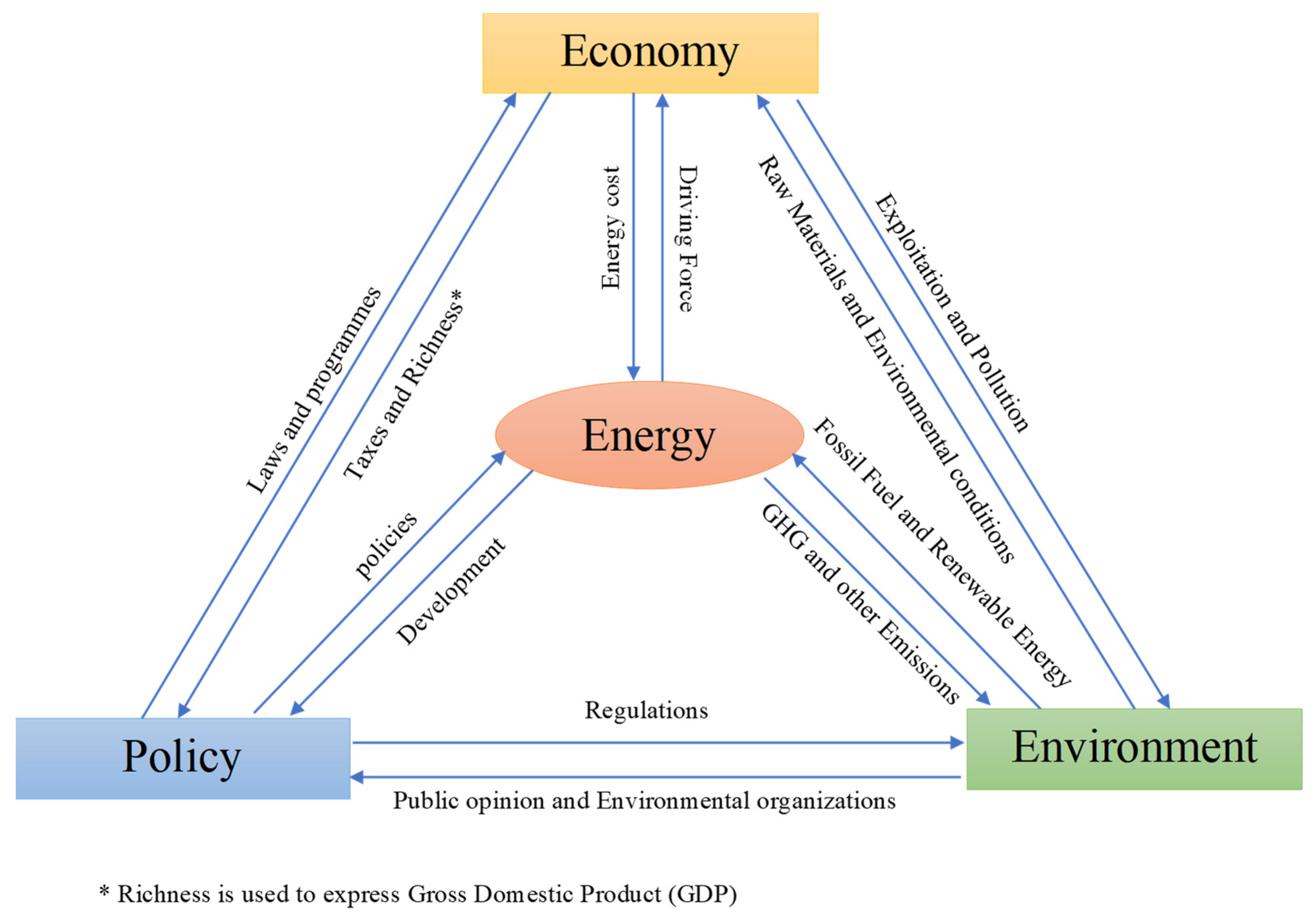
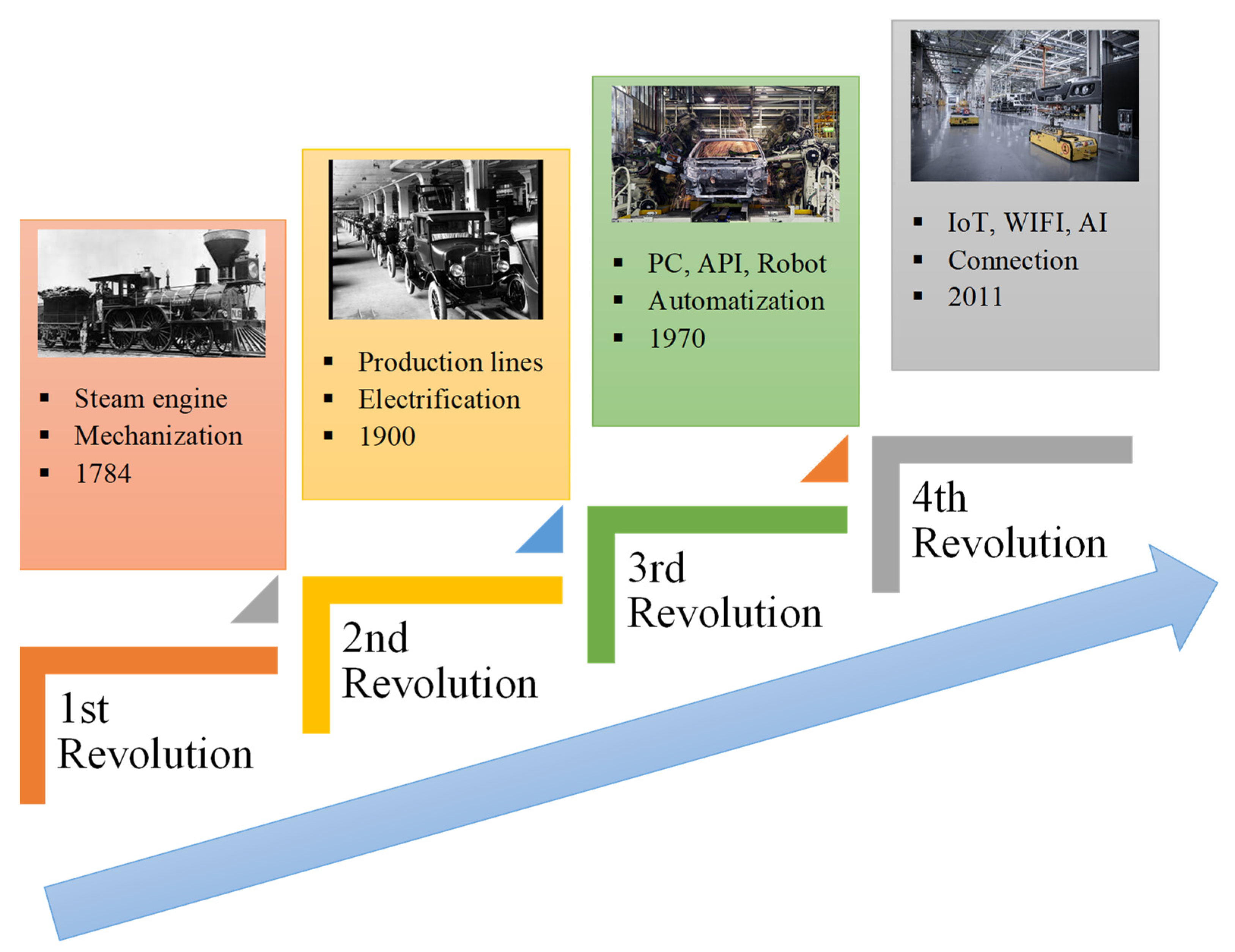
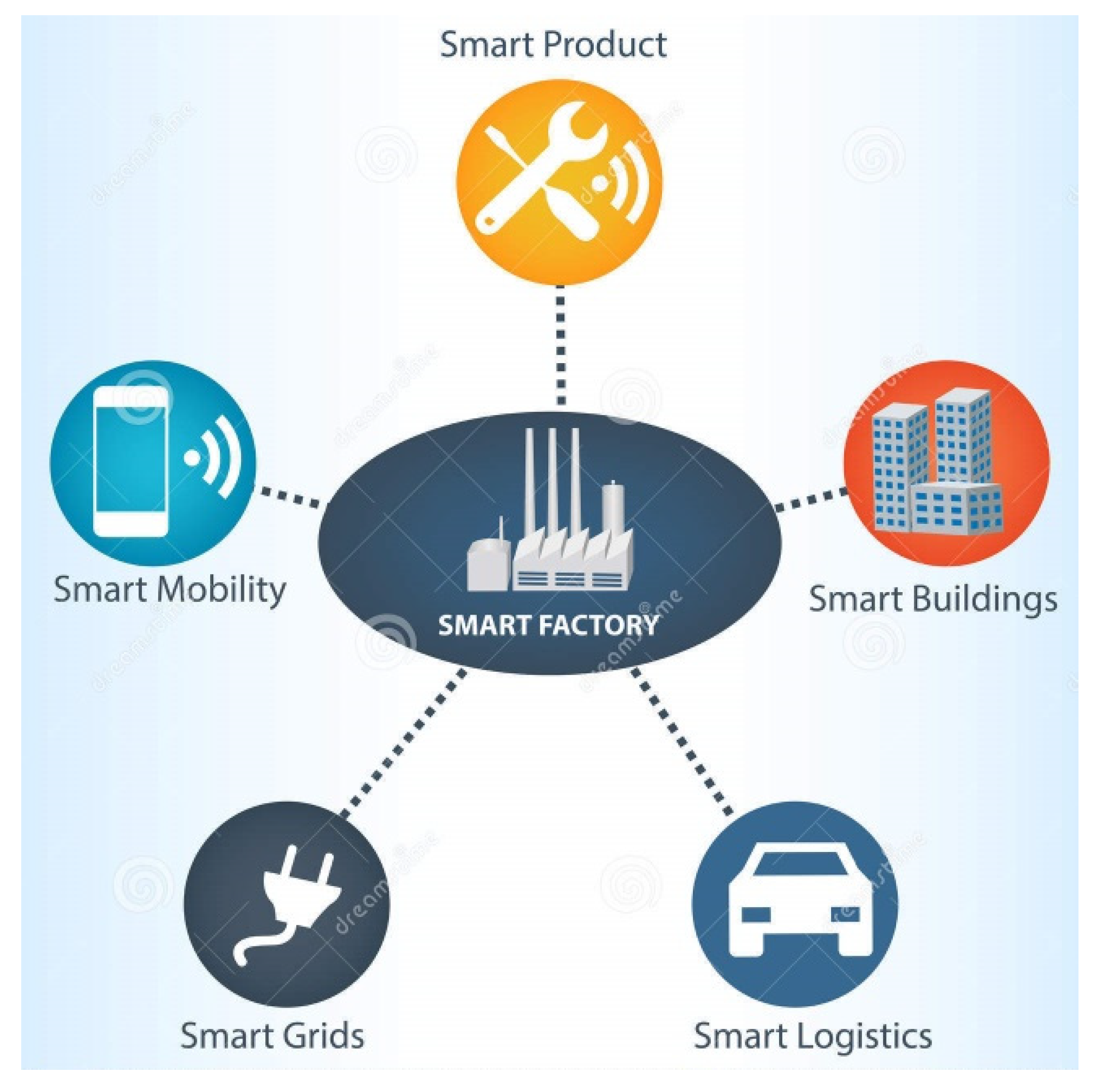
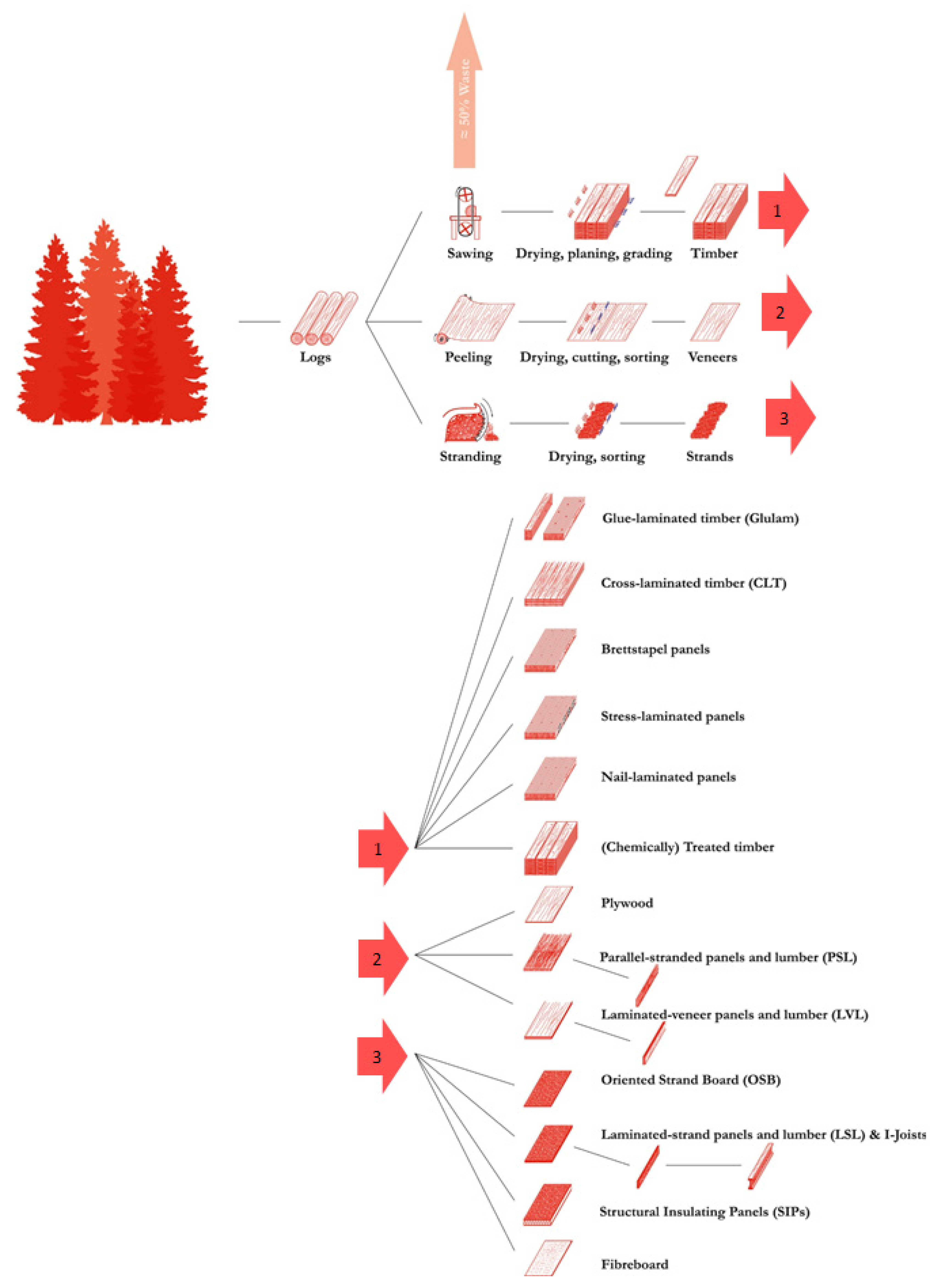
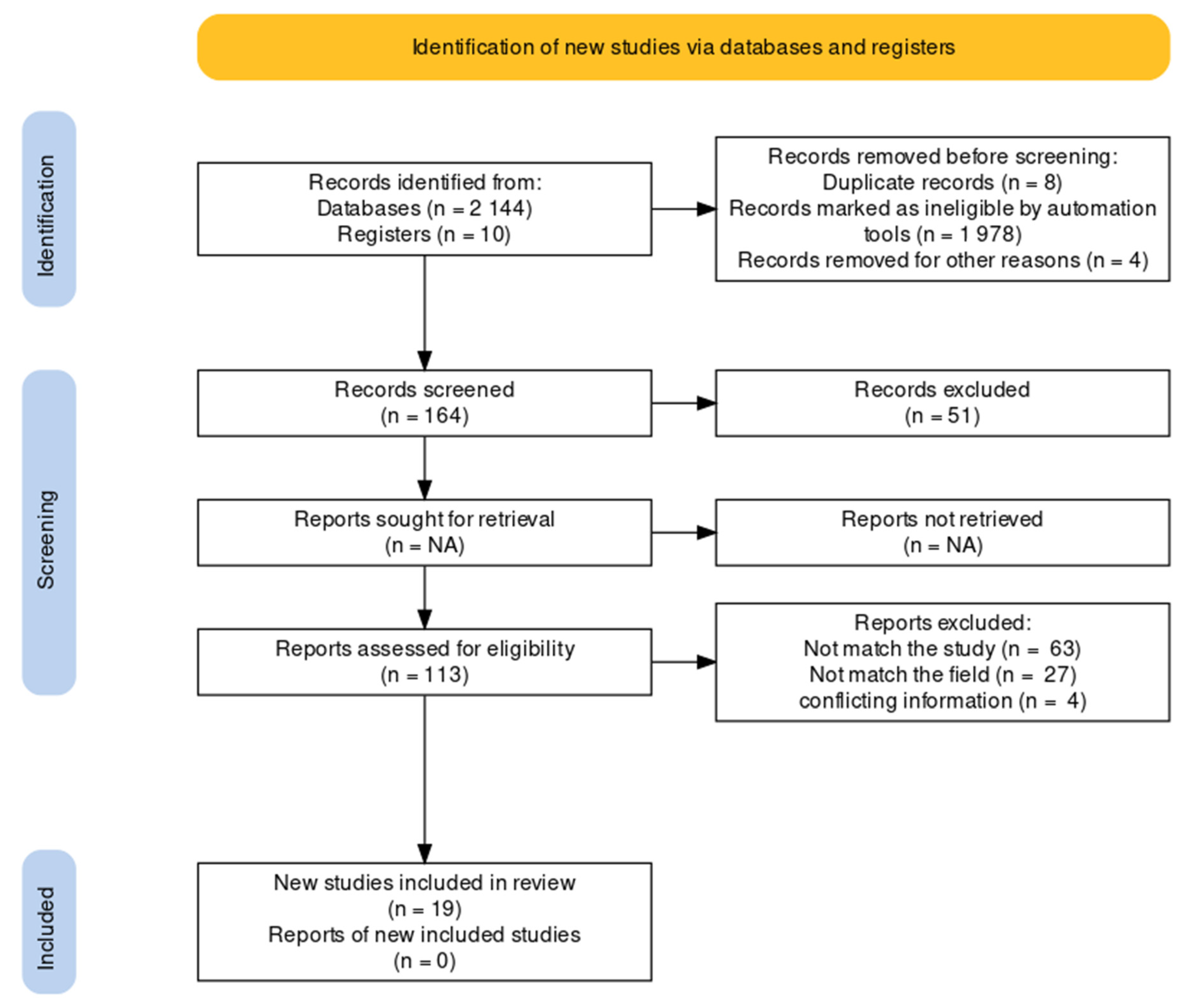

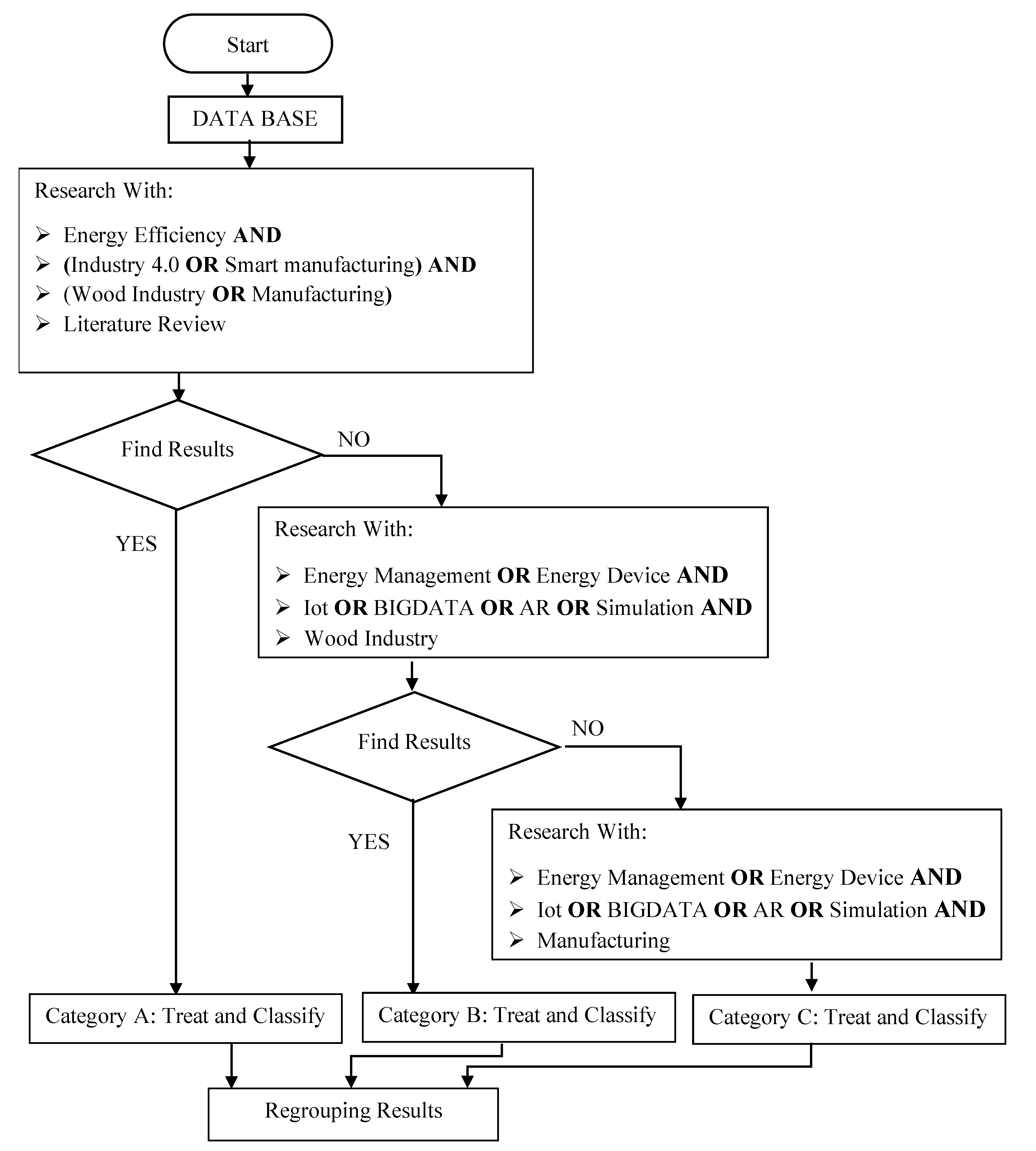
| Data Base | Articles |
|---|---|
| IEEExplore | [73,77,97,98,99] |
| ELSEVIER | [71,100,101,102,103] |
| Springer Link | [1,76] |
| MDPI | [104,105,106] |
| ACM digital library | [69] |
| ResearchGate | [107,108] |
| Semantic Scholar | [109] |
| Articles | Energy Efficiency | Industry 4.0 | Application | |||||||
|---|---|---|---|---|---|---|---|---|---|---|
| Category | Reference | Energy Management | Energy Devices | IoT | Big Data | AR | Simulation | Others | Wood industry | Others |
| A | [1] | X | X | X | X | |||||
| [102] | X | X | X | X | X | X | ||||
| [103] | X | X | ||||||||
| [105] | X | X | X | X | ||||||
| [106] | X | X | X | X | ||||||
| [108] | X | X | X | X | X | X | ||||
| B | [107] | X | X | X | X | X | X | |||
| C | [69] | X | X | X | ||||||
| [71] | X | X | X | X | ||||||
| [73] | X | X | X | |||||||
| [76] | X | X | X | X | X | X | X | |||
| [77] | X | X | X | X | ||||||
| [97] | X | X | X | |||||||
| [98] | X | X | X | X | X | |||||
| [99] | X | X | X | X | X | X | X | |||
| [100] | X | X | X | X | ||||||
| [101] | X | X | X | |||||||
| [104] | X | X | X | X | X | |||||
| [109] | X | X | X | |||||||
Publisher’s Note: MDPI stays neutral with regard to jurisdictional claims in published maps and institutional affiliations. |
© 2022 by the authors. Licensee MDPI, Basel, Switzerland. This article is an open access article distributed under the terms and conditions of the Creative Commons Attribution (CC BY) license (https://creativecommons.org/licenses/by/4.0/).
Share and Cite
Haddouche, M.; Ilinca, A. Energy Efficiency and Industry 4.0 in Wood Industry: A Review and Comparison to Other Industries. Energies 2022, 15, 2384. https://doi.org/10.3390/en15072384
Haddouche M, Ilinca A. Energy Efficiency and Industry 4.0 in Wood Industry: A Review and Comparison to Other Industries. Energies. 2022; 15(7):2384. https://doi.org/10.3390/en15072384
Chicago/Turabian StyleHaddouche, Mohamed, and Adrian Ilinca. 2022. "Energy Efficiency and Industry 4.0 in Wood Industry: A Review and Comparison to Other Industries" Energies 15, no. 7: 2384. https://doi.org/10.3390/en15072384
APA StyleHaddouche, M., & Ilinca, A. (2022). Energy Efficiency and Industry 4.0 in Wood Industry: A Review and Comparison to Other Industries. Energies, 15(7), 2384. https://doi.org/10.3390/en15072384







